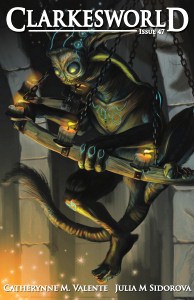Clarkesworld Magazine #47
August 2010
“Thirteen Ways of Looking at Space/Time” by Catherynne M. Valente
“The Messenger” by Julia M. Sidorova
Reviewed by Bob Blough
This issue of Clarkesworld contains two stories with religious themes and significance. In my mind stories using the Bible as a basis must be judged by two great mid 20th century works–Behold the Man by Michael Moorcock and “The Deathbird” by Harlan Ellison. Each of these stories is, to me, the epitome of how SF can be used to examine cherished beliefs. How do these new stories hold up?
“The Messenger” by Julia M. Sidorova is the more conventional narrative. In the Bible, the meaning of the word angel is messenger, and as I started the narrative and realized this was about Gabriel and his message to Mary I was a bit scared. Often stories retelling or reinterpreting this kind of text can so easily stray into cliché or ranting or just plain didactic critique, but Ms. Sidorova manages to avoid all these pitfalls. The story starts with the annunciation–the angel named Gabriel is sent by God to Maria to impregnate her with God’s “seed.” He, as a messenger, does this, but he becomes more and more invested in the continuing story of Maria and eventually Joshua, her son. He begins to doubt the veracity and loving kindness of the one who sent him to do his bidding.
The characters are nicely drawn and the portions that are directly from the Bible are given nice twists of their own as seen though the eyes of Gabriel. And the “fantastic” elements are given a science fiction rationale. It is less subversive than Behold the Man, and thus less important, but it’s a well written story dealing with an interesting subject. It raises important questions for those of us who try to follow the teachings of Christ.
“Thirteen Ways of Looking at Space/Time” by Catherynne M. Valente is more in the vein of Ellison’s “The Deathbird.” Both use very personal stories to enhance the science fictional aspect of their individual works. Ellison told the story of the death of his dog, Abhu, while Valente tells her own creation story. She tells how she became the person she is and the SF writer she has become. I must say here that while the personal aspects of this story seem partially auto-biographical I do not know if that is true. If it is, then Ms. Valente has guts; if they are not then she has created such a true character that her character seems real enough to be autobiographical. Either way it’s a high achievement.
In “Thirteen Ways of Looking at Space/Time” Valente “science fictionalizes” 7 different mythologies, starting with Genesis and going through the Aztec, Greek, two American Indian versions, and Japanese and Scandinavian creation stories as well. These 7 chapters interspersed between the “real story” are beautifully written. Let me say right here that I am enamored of the way Ms. Valente writes. She puts words and concepts together in ways that no one else does. She is a one of a kind author and we are lucky to have her. She dazzles here. The science fictionalization of these stories makes us see them anew; almost as if she was retelling them to this generation of the believers in Science.* It helps me see these stories in a new and powerful light. Wonderful!
*(An interesting side note are the comments people leave following each online story. I enjoy reading them as it provokes further discussion. One such comment following the Valente story came from Vandana Singh–herself one of the greatest unsung new writers of SF. Singh says that this put her off the story because Valente was using the scientific jargon as poetry rather than making sense as science. Fair enough, but all I can say is that as a non-scientist I was engulfed by the mystery of creation by this poetic license in ways that no rigorous science fiction story has yet done for me. Poetically it did exactly what I believe it was meant to do.)
Between the aforementioned 7 chapters are 6 chapters of a contemporary SF writer that bring this story firmly into the lives of us all and make it more than just a retelling of various creation stories. These chapters are the beautifully told tale of the character’s own creation story. Many different parts of her are “created,” from becoming a science fiction writer to the dissolution of her marriage to the remembrance of “being born,” which is composed of various true memories as a young child. The story is ultimately a story of victory, of overcoming the glass ceiling, or whatever may stand between our lived experiences and the creation of who we really are. And it tells us this through the tropes and enticements of science fiction. This is definitely one of the very best stories of the year. I don’t know if it will rank as high as “The Deathbird” in my personal list of best loved SF/F stories, but for me it is a story that will be remembered.